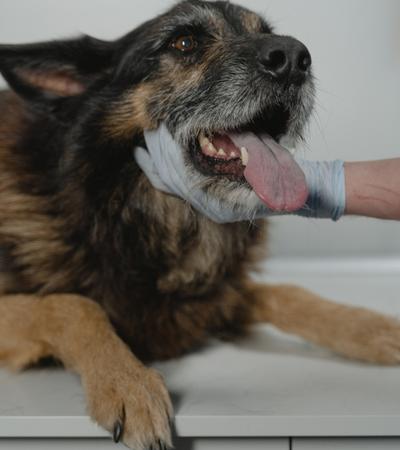Anaphylactic shock in dogs is extremely serious. Yet it’s probably one of the last things on your mind when you bring your new puppy home for the very first time. However, in the same way, as human allergies can cause anaphylaxis, it can also happen to hounds.
Allergies are caused by hypersensitivity or overreaction of the immune system, this occurs when your dog comes into contact, inhales, or ingests a particular substance. Several allergens are known to cause allergy symptoms in dogs and in rare cases, dogs with allergies can suffer from anaphylactic shock.
Anaphylactic Shock in Dogs Contents

Dogs can be allergic to many different substances. From their food, fleas, and even certain environmental factors. Did you know, dogs can even be allergic to cats?
Allergies are often caused by certain proteins found in animal skin (dander), fish, insects, and plants. Experts reveal that pooches with environmental allergies rocketed by 30.7 percent over the last decade.
Knowing what may have set off your dog’s reaction will help you to keep them safe and limit the chance of the sensitivity recurring in the future.
Here is a roundup the most common dog allergies:
Environmental
Dogs can be allergic to microscopic substances in the air. Your woof woof may be exposed to allergens at home — dust mites, mold and spores, and house dust. The culprit could also be outside waiting to strike down your pooch when out for walkies.
Pollen and grass are prime triggers that lead to sneezing, excessive skin nibbling as well as scratching. If you suspect a sensitivity to grass, why not check out our allergy to grass 101.
Food
Unfortunately for your hungry pup, food allergies are very common. It’s a misconception that only poor-quality food can cause an allergic reaction. Some of the most common allergens found in dog food include:
- Beef.
- Egg.
- Soy.
- Gluten.
- Lamb.
- Chicken.
- Dairy products.
Certain brands of dog food may trigger an allergic reaction due to the filler ingredients they use to bulk out their products. However, as with humans, your dog will need to be tested before you can say for sure what specific foods prompt their allergy symptoms.
Food allergies can be diagnosed by your vet running tests and putting your dog on a special elimination diet. By removing certain foods from your dog’s dinner plate and only feeding them one type of protein or carbohydrate at a time, you will be able to identify exactly what ingredient is responsible for their allergy.
Fleas/Insects
As if fleas weren’t a big enough nuisance already, these tiny little bugs can also cause some canines to experience an allergic reaction. It’s not the flea itself that dogs are allergic to, it’s the protein found in their saliva that causes all the problems.
What’s more, dogs that frequently suffer from fleas don’t tend to develop the allergy, instead, it’s the tail-waggers who rarely come into contact with fleas who are likely to suffer. If your dog doesn’t get plagued by fleas, a single bite can be all that’s needed to trigger a reaction.
Flea allergies are easy to diagnose and treat. If your dog is found hosting these jumping parasites and is suffering allergy symptoms, they will be given a flea-killing treatment to prevent any further bites and reactions.
Bees, ticks, wasps, and ants — any kind of biting or stinging insect — can also spark a reaction. All of which can leave your pooch with swelling and pain.
Seasonal
Dogs can suffer from the changes in seasons, just like us humans. As the pollen levels begin to rise, your fur-baby may start sneezing uncontrollably or scratching continually.
Your fur-baby can be allergic to certain weeds, plants, and grasses that only grow at certain times of the year. If they appear fine during the fall but display signs through the spring and warmer months, seasonal allergies are likely to blame.
Learn more by reading our guide to seasonal allergies.
Staphylococcus
As well as their food and particles in the air around them, dogs can also be allergic to the Staphylococcus bacteria that’s naturally occurring on their skin. A canine’s immune system can overreact to the Staph bacteria and create a hypersensitivity, leading to scratching and biting. A bacterial hypersensitivity is most likely to occur if your dog has other health conditions, such as hypothyroidism or another allergy.

Anaphylactic shock in dogs is a severe and immediate allergic reaction. Often, it will only occur when your pooch comes into contact with an allergen they have already had a milder reaction to in the past. For instance, if a flea bite is the trigger of your dog’s allergies, another bite could lead to anaphylaxis.
Unlike a more mild allergic reaction, the symptoms develop rapidly and are serious.
Anaphylaxis in dogs can also be localized or systemic. For example, if a flea bite is responsible, a localized reaction will manifest as severe swelling and redness at the site of the bite.
However, a systemic reaction is caused when the localized reaction releases more mast cells — the cells responsible for redness and swelling — throughout the rest of the body. A systemic dog anaphylactic shock is rare but can cause death if not treated promptly.
If you’re aware of a family history or your pooch has suffered allergic reactions in the past — it’s super essential you familiarize yourself with the symptoms of anaphylactic shock in dogs.
To help you to keep your bow-wow safe, here is a list of the major symptoms of dog anaphylactic shock:
- Swollen face/muzzle.
- Excessive drooling.
- Vomiting.
- Diarrhea.
- Itching.
- Swelling.
- Seizures.
- Cold limbs.
- Red skin (wheals or hives).
- Breathing difficulties.
- Blue tongue/gums.
Anaphylaxis is a medical emergency.
Hence, if your loyal companion displays any of the above signs after they have come into contact with a potential allergen, seek treatment without delay.

Immediate Treatment
We’ve said it once, but will stress this again — you must seek urgent medical attention if your dog goes into anaphylactic shock. Your vet will treat your dog by:
1. Removing the allergen — If possible, your vet will remove the substance causing the reaction. For example, a bee’s stinger or an insect/flea.
2. Stabilizing treatment — Once the allergen is removed, the vet will work to stabilize your dog’s condition and prevent the allergic reaction from progressing. Epinephrine (adrenaline) injections are the most effective course of action, along with antihistamines and hydrocortisone. Some pooches may also require oxygen and IV fluids.
3. Monitoring — Your fur-baby will need to be closely monitored for a day or two afterward. If their episode was serious, it means remaining with your vet for a few nights, until your pooch receives the all-clear.
Long-Term Care
Thankfully, doggie parents don’t have to live in constant fear of their furry friend’s allergies. Treatments are available for anaphylaxis, like the EpiPen for dogs.
Vets will be able to discuss prescribing pet owners a dog EpiPen — correct dosage is crucial. Often, it’s only prescribed if the pup is allergic to insect bites and stings. Doggie owners are advised to take the EpiPen with them on walkies and to use it immediately if their pooch goes into anaphylactic shock.
Food allergic reactions can be easily avoided by preventing your furry friend from ingesting any known allergens. However, it’s impossible to predict if and when an insect may bite or sting your dog, that’s why an EpiPen proves useful.
This automatic injection device contains epinephrine and can help to ease your dog’s symptoms long enough for you to seek medical care from a vet. However, it’s essential to note that even after administering the drug, your dog will still require treatment from the vet to stabilize and monitor their condition.
Conclusion
We’ve discussed the important information about dogs with allergies, the signs of anaphylactic shock, and what to do in the event of an episode. Whatever is causing your dog’s allergy symptoms, whether it’s fleas, chicken, or grass pollen, now you’re prepared for the unexpected.
Anaphylaxis can be a serious and life-threatening condition. However, by identifying what your pooch is allergic to and recognizing the symptoms of anaphylactic shock in dogs, their allergies don’t have to rule their life.
“How Can I Treat My Dog for Allergies at Home?”
From oat baths to baking soda treatments, why not check out our guide to home remedies for dog allergies.
“Can Dogs Survive Anaphylactic Shock?”
Yes. Providing the condition is dealt with swiftly. If left untreated, an anaphylactic reaction in dogs can become systemic and cause swelling to the respiratory system and parts of the body.
“How Quickly Does Anaphylactic Shock Happen in Dogs?”
Within minutes of exposure to the allergen, dogs will begin to show signs of anaphylactic shock. However, in dogs, the main organ affected is actually their liver rather than the lungs as with other domestic animals.
“What Are Two Signs of Anaphylactic Shock?”
There are many signs of anaphylactic shock in dogs such as:
- Diarrhea.
- Cold legs.
- Seizures.
- Pale gums.
“Will Benadryl Stop Anaphylaxis?”
Unfortunately, a dose of Benadryl is not going to be sufficient to treat anaphylaxis in your dog. It will help relieve allergy symptoms, but it works too slowly to treat a severe reaction.


